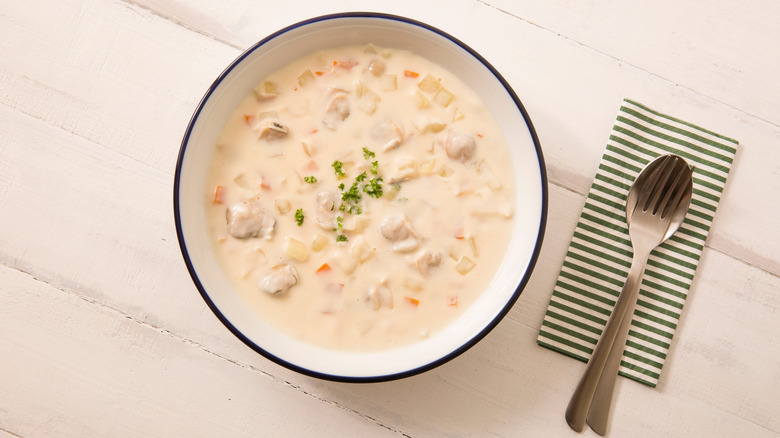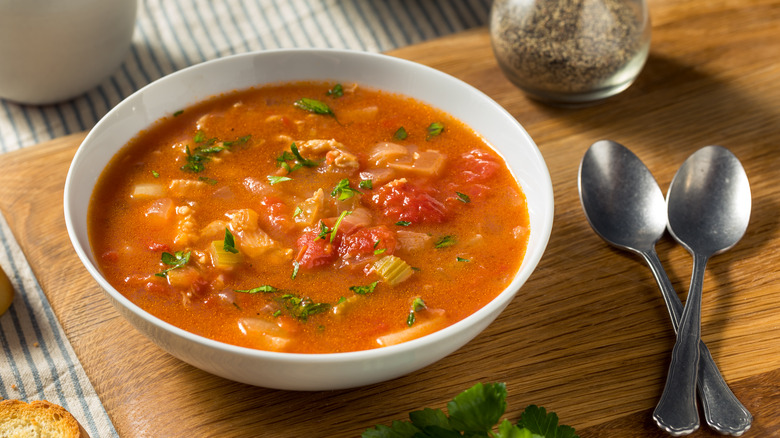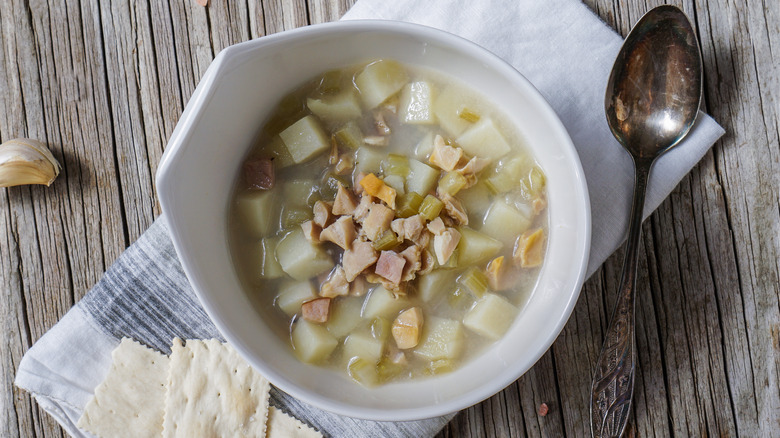The 3 Most Popular Types Of Clam Chowder, Explained
Foodies have been enjoying clam chowder for centuries, and the dish has endured for a reason. It's warm, savory, filling, and doesn't require any complicated techniques to make. Essentially, you toss all the ingredients in a large pot and cook. Plus, clams are high in lean protein (we're talking 12 grams of protein per 3-ounce serving high) and rich in omega-3s, which promote heart health, says Healthline.
The story goes that clam chowder first hit New England shores sometime around the 1700s. According to Eater, settlers from France, Britain, and Nova Scotia brought the dish with them. The name "clam chowder" derives from the French "chaudiere," per Serious Eats, which refers to the large pot in which the dish would have been cooked. There's an alternative theory that the etymological origin is the "jowter," a kitchen device used in 16th-century coastal England. Either way, it didn't take long before home cooks began making it on a regular basis. Fans were so hungry for the dish that they created three different versions of it. The New England version came first, then Manhattan and Rhode Island clam chowders cropped up, and the rest is history (literally). So, what's the difference?
New England
New England clam chowder is perhaps the most popular and well-known iteration of the dish. It's a classic combination of clams, onions, corn, celery, bacon or salt pork, and potatoes. Chef Ryan Hardy of The Coach House on Martha's Vineyard is one of the dish's biggest fans. It's an enduring local favorite that even New England transplants like Hardy himself celebrate unabashedly, per the James Beard Foundation. The chef says he has a bowl pretty much every day.
New England is famous for its signature mild flavor and pale white color, which comes from one crucial ingredient: cream. You can even use dry vermouth to spice it up a bit. But, according to local outlet New England Today, white pepper, thyme, and a few bay leaves are all it takes to achieve classic New England-style chowder. And, says the outlet, bacon is fine, but salt pork is the true New England way. (If you want to taste the local flair for yourself, Rory's Restaurant in Darien, Connecticut, serves a killer bowl.)
Manhattan
Like the New England varietal, Manhattan (aka "Coney Island" and "Fulton Market") clam chowder features celery, onion, and bacon as its foundational building blocks. But what makes Manhattan clam chowder unique is the tomatoes, which are also responsible for the dish's signature red hue. Think Clamato, but soup. As The New York Times puts it, "You either like Manhattan clam chowder or you don't." James Beard himself once wrote: "that rather horrendous soup called Manhattan clam chowder...resembles a vegetable soup that accidentally had some clams dumped into it," via What's Cooking America.
Like so many beloved comfort dishes, Manhattan clam chowder was the child of cultural fusion. As Italian and Portuguese immigrants flocked to New York fishing communities during the mid-1800s, they added ingredients to classic clam chowder like bell pepper and crushed red pepper flakes. New York's Delmonico restaurant is regarded as the dish's unofficial birthplace. In 1889, Alessandro Filippini (Delmonico's chef du maison for 14 years) wrote a cookbook that included an official recipe for Manhattan clam chowder.
Celebrity chef Emeril Lagasse says diced carrot, bell pepper, crushed red pepper flakes, parsley, and oregano all belong in the recipe, per Food Network. Notably, tomato juice and chicken stock provide the liquid components for Manhattan chowder; there's no heavy cream to be found here. It makes for a thinner mouthfeel and a slightly spicy bite, while the acidic tomatoes and salty clams make for a complementary, dimensional flavor profile.
Rhode Island
In addition to 400 miles of shoreline, Rhode Island also has its own version of clam chowder. Rhode Island may not actually be an island (it technically isn't even a peninsula), but what it lacks in straightforward advertising, it makes up for in gastronomic aptitude. (Pretty big cultural footprint for the smallest state in America.)
Unlike the thick white New England style or the red Manhattan style, Rhode Island clam chowder is clear. The quintessential bacon, onions, and celery are still there, but the primary ingredient in Rhode Island clam chowder's broth is clam juice, says Yankee Magazine, which doesn't lend much color or viscosity to speak of. It's the most stripped-down, clam-forward chowder iteration in our lineup. To make it in your home kitchen, Food Network and Martha Stewart recommend using Quahog clams. Quahog (COE-hog) clams are the biggest clam type. It isn't uncommon for just one Quahog to weigh in at half a pound, says The Kitchn. Their size makes them the most common choice for recipes; it's no secret why cooks reach for Quahog clams when making chowders like this one.



